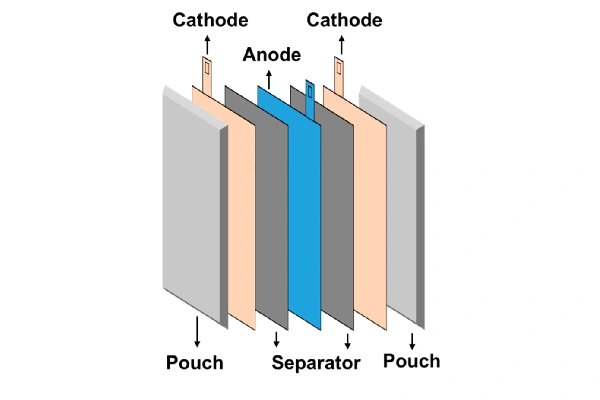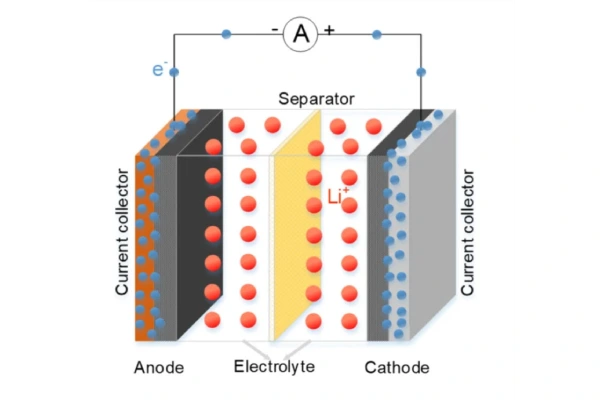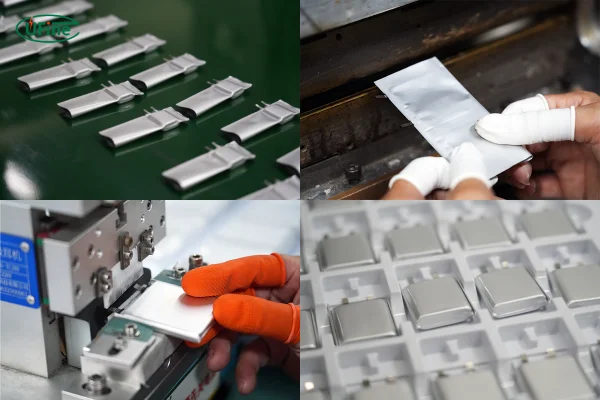Pouch cells have become increasingly popular in various applications, from smartphones to electric vehicles. Their unique design and high energy density make them a preferred choice in many industries. This article will explore what pouch cells are, their structure, how they work, how they are manufactured, their pros and cons, and how they compare to other types of batteries.
Part 1. What is the pouch cell?
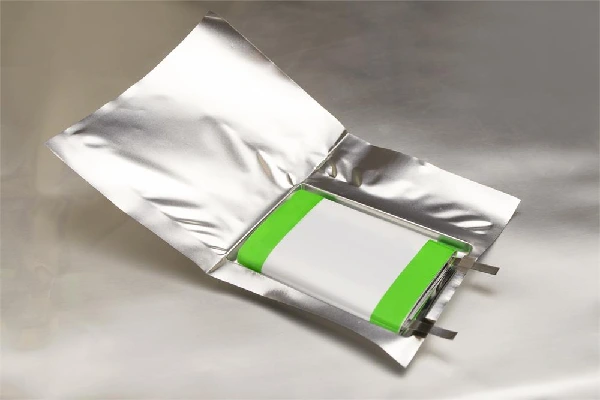
A pouch cell is a lithium-ion battery characterized by its flexible, lightweight casing. Unlike traditional cylindrical or prismatic cells, pouch cells use a laminated foil casing, which allows for various shapes and sizes. This flexibility makes them ideal for applications where space and weight are critical factors. Pouch cells are widely used in consumer electronics, electric vehicles, and energy storage systems due to their high energy density and customizable design.
Part 2. Pouch cell structure and assembly
Pouch cells consist of several key components, each playing a crucial role in the cell’s function:
- Cathode: The positive electrode, typically made from lithium cobalt oxide (LiCoO2), lithium manganese oxide (LiMn2O4), or lithium iron phosphate (LiFePO4). The cathode stores lithium ions during charging.
- Anode: The negative electrode, usually made from graphite. The anode releases lithium ions during discharge.
- Electrolyte: A liquid or gel that facilitates the movement of lithium ions between the cathode and anode. Common electrolytes include lithium salt dissolved in an organic solvent.
- Separator: A thin, porous membrane that keeps the anode and cathode apart, preventing short circuits while allowing ion flow.
- Pouch: A flexible, laminated foil that encases the internal components. This pouch is typically made from layers of aluminum and plastic, providing both protection and flexibility.
The assembly process involves stacking the layers of the cathode, separator, and anode, injecting the electrolyte, and then sealing the pouch. This design allows for maximum energy density and flexibility in shape and size.
Part 3. How does the pouch cell work?
The working principle of a pouch cell revolves around the movement of lithium ions between the anode and cathode. Here’s a simple breakdown:
- Charging: When the cell charges, lithium ions move from the cathode to the anode through the electrolyte. Electrons flow through the external circuit, balancing the charge.
- Discharging: During discharge, lithium ions move back from the anode to the cathode, generating an electric current in the external circuit.
This ion movement is facilitated by the electrolyte and controlled by the separator, ensuring ions move smoothly while preventing direct contact between the anode and cathode.
Part 4. How does the factory manufacture pouch cells?
Manufacturing pouch cells is a precise and complex process involving several steps:
- Preparation of Materials: Raw materials for the cathode, anode, and electrolyte are prepared. This includes mixing active materials with binders and solvents.
- Coating: The prepared materials are coated onto metal foils (aluminum for the cathode and copper for the anode).
- Drying and Pressing: The coated foils are dried to remove solvents and then pressed to ensure uniform thickness and adherence.
- Cutting and Stacking: The coated foils are cut into desired sizes and stacked in layers, alternating between the cathode, separator, and anode.
- Electrolyte Filling: The stack is placed in a pouch, and the electrolyte is injected into the cell.
- Sealing: The pouch uses heat and pressure to prevent electrolyte leakage.
- Formation and Testing: The cells undergo formation cycles, where they are charged and discharged to activate the materials. They are then tested for performance, capacity, and safety.
Part 5. Pouch cell Pros and Cons
Pros:
- High Energy Density: Pouch cells can store much energy in a small space, making them ideal for compact devices.
- Lightweight: The flexible pouch casing reduces weight compared to rigid metal casings.
- Flexible Design: Pouch cells can be manufactured in various shapes and sizes to fit specific applications.
- Good Thermal Performance: Their design allows for better heat dissipation, which can improve safety and performance.
Cons:
- Safety Concerns: Pouch cells are more prone to swelling and punctures, leading to safety issues if not properly managed. They require careful handling and robust safety measures to prevent accidents.
- Complex Manufacturing: The manufacturing process of pouch cells is more intricate and precise than other battery types, which can increase production costs.
- Cost: Generally, pouch cells are more expensive than cylindrical and prismatic cells due to their complex manufacturing process and the need for high-quality materials.
Part 6. 18650 vs. prismatic cell vs. pouch cell: what is the difference?
| Criteria | 18650 Cell | Prismatic Cell | Pouch Cell |
|---|---|---|---|
| Form Factor | Cylindrical, standard size (18mm x 65mm) | Flat, rectangular shape | Flexible, flat, and lightweight |
| Energy Density | Moderate to high (150-250 Wh/kg) | Moderate (90-160 Wh/kg) | Higher (150-250 Wh/kg) |
| Thermal Management | Good thermal management | Excellent thermal stability | Needs careful thermal management |
| Manufacturing Cost | Lower cost due to mass production | Generally higher due to complex design | Lower manufacturing cost |
| Cycle Life | Good cycle life (up to 1,000 cycles) | Excellent (up to 3,000 cycles) | Moderate (up to 1,500 cycles) |
| Safety | Moderate risk of thermal runaway | Very safe, low risk of failure | Moderate risk if punctured |
| Applications | Used in laptops, power tools, EVs | Common in EVs, energy storage systems | Found in smartphones, tablets, drones |
Part 7. How to check whether the pouch cell is of good quality?
As a savvy consumer, there are several key factors you can consider when evaluating the quality and reliability of a pouch cell before making a purchase.
1. Visual Inspection
One of the first steps in assessing the quality of a pouch cell is a thorough visual inspection. Look for signs of physical damage, such as dents, creases, or bubbles in the pouch casing. These could be indicative of manufacturing defects or improper handling during the supply chain. Additionally, examine the seals and edges of the pouch for any signs of leakage or compromised integrity.
2. Manufacturer’s Certification and Documentation
Reputable pouch cell manufacturers will provide comprehensive documentation and certifications to assure consumers of the product’s quality. This may include test reports, safety certifications (such as UL, CE, or UN38.3), and detailed specifications outlining the cell’s performance metrics, such as energy density, cycle life, and capacity.
3. Key Performance Metrics
When evaluating the quality of a pouch cell, it’s essential to examine the performance metrics most relevant to your application. These may include:
- Energy density (Wh/kg or Wh/L): Higher energy density indicates a more efficient use of space and weight.
- Cycle life: The number of charge-discharge cycles the cell can withstand before reaching end-of-life.
- Charge/discharge rate: The maximum current the cell can handle during charging and discharging.
- Operating temperature range: The cell’s ability to function within the required temperature conditions.
- Safety features: Advanced safety mechanisms such as overcharge/overdischarge protection, thermal runaway prevention, and short-circuit protection are present.
4. Manufacturer Reputation and Track Record
The reputation and track record of the pouch cell manufacturer can provide valuable insights into the overall quality and reliability of the product. Research the company’s history, industry experience, and any notable achievements or accolades they may have earned. Consider reaching out to existing customers or reviewing industry reports to gauge the manufacturer’s reputation and customer satisfaction levels.
5. Third-Party Testing and Validation
In some cases, it may be beneficial to seek out independent third-party testing and validation of the pouch cell’s performance and safety. Reputable testing organizations can provide unbiased assessments and certifications that can give you additional peace of mind when purchasing.
6. Warranty and After-Sales Support
A robust warranty and reliable after-sales support from the manufacturer can be valuable indicators of the pouch cell’s quality and the company’s commitment to customer satisfaction.
Part 8. Are pouch cells the safest?
While pouch cells offer many advantages, they do come with certain safety concerns. Their flexible casing makes them more susceptible to physical damage, leading to swelling or even fire if the cell is punctured. However, with proper design and safety features such as robust separators, pressure release mechanisms, and advanced battery management systems, pouch cells can be made very safe. Manufacturers often incorporate multiple layers of protection to ensure the cells operate safely under various conditions.
Part 9. Where is the pouch cell used?
Pouch cells are versatile and find application in a wide range of devices and systems:
- Smartphones: Due to their slim profile and high energy density, pouch cells are ideal for modern smartphones.
- Tablets: They provide high energy in a compact size, making them suitable for tablets that require long battery life.
- Electric Vehicles (EVs): Pouch cells are used in EVs for their high energy density and lightweight properties, contributing to longer driving ranges and better efficiency.
- Drones: The lightweight and high-power characteristics of pouch cells make them perfect for drones, which need efficient power sources without adding excessive weight.
- Wearable Devices: Pouch cells’ customizable shape and size allow them to fit into various wearable devices, providing reliable power in a small form factor.
Part 10. Pouch cell transportation and storage tips
Transportation Tips:
- Regulations: Follow all relevant regulations for the transportation of lithium-ion batteries. This includes packaging, labeling, and documentation requirements.
- Proper Packaging: Use appropriate packaging to protect the cells from physical damage and short circuits. This often involves non-conductive materials and cushioning to prevent movement during transit.
- Avoid Extreme Temperatures: Transport cells in environments with controlled temperatures to avoid exposure to extreme heat or cold, which can affect their performance and safety.
Storage Tips:
- Cool, Dry Place: Store pouch cells in a cool, dry place away from direct sunlight and moisture. Ideal storage temperatures are typically between 15°C and 25°C (59°F and 77°F).
- Partially Charged State: Keep cells at a partial charge (around 50-60%) for long-term storage to minimize capacity loss and degradation.
- Regular Checks: Periodically check the cells for signs of swelling, leakage, or damage. This ensures that any issues are detected early and addressed promptly.
Pouch cells are a remarkable innovation in the field of lithium-ion batteries, offering high energy density, lightweight design, and flexibility in shape and size. While they have some safety concerns and higher manufacturing costs, their advantages make them indispensable in modern technology. Understanding their structure, working principles, and proper handling can help maximize their benefits and ensure their safe use.
Related Tags:
More Articles
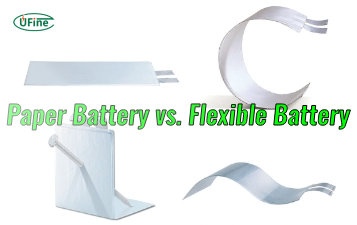
Paper Battery vs. Flexible Battery: What’s the Difference and Which Is Better?
Paper vs. flexible batteries: learn the key differences, benefits, and which power source fits best for wearables, sensors, and smart tech.
What to Know Before Buying a Tiny LiPo Battery for Your Project
Tiny LiPo batteries are powerful and compact. Learn how to choose the right one for your project with specs, safety, and charging tips.
Bloated LiPo Battery: Will It Explode?
Will a bloated LiPo battery explode? Discover the causes, risks, safety steps, and expert tips to avoid disaster and protect your gear. Must-read safety guide!
12V 100Ah Lithium Ion Battery Price: Full Guide
Learn about 12V 100Ah lithium-ion battery price, from cost ranges to best brands, hidden fees, and how to get the best deal. A must-read for smart buyers!
Resistance and Conductivity: What It Means for Your Lithium Batteries
Resistance and conductivity impact lithium battery performance, lifespan, and safety—learn how they work and why they matter.
